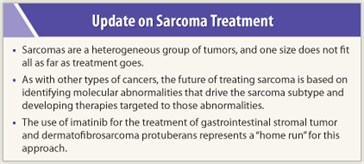Does one size fit all for the treatment of sarcoma? The answer is a resounding “no,” according to Jean-Yves Blay, MD, Department of Medicine, Université Claude Bernard, and Unité INSERM (National Institute of Health and Medical Research Unit), Lyon, France. Researchers have been able to classify sarcomas into subtypes according to driving molecular alterations, and the identification of these abnormal pathways has led to the development of targeted agents for these subtypes—some quite effective, he explained. Another boon attributable to the identification of driving molecular alterations is that sarcomas represent optimal models for the development of targeted therapy.
Over 100 Subtypes
 “Sarcoma is a heterogeneous group of more than 50 histotypes, without taking grading into account, and there are probably more than 100 molecular subtypes, Dr. Blay told listeners at the recent European Multidisciplinary Cancer Congress in Stockholm.
“Sarcoma is a heterogeneous group of more than 50 histotypes, without taking grading into account, and there are probably more than 100 molecular subtypes, Dr. Blay told listeners at the recent European Multidisciplinary Cancer Congress in Stockholm.
Although these discoveries are exciting, adapting treatment of sarcomas according to histology is still controversial for most subtypes at present, Dr. Blay noted. He and his colleagues are presently working on two large sets of research projects in this area. One is testing new treatments that target a protein or pathway that is driving a particular tumor subtype. In addition, the group is studying sarcomas without known driving forces—those with complex genetic alterations—and looking for additional mutations that may be responsible for tumor growth.
Sarcoma Subgroups
Five subgroups of sarcomas have been identified:
- Sarcomas with specific translocations and fusion oncogenes (Ewing’s sarcoma, synovial sarcoma, alveolar rhabdomyosarcoma, and desmoplastic small round cell tumor)
- Sarcomas with tyrosine kinase mutations (KIT in gastrointestinal stromal tumor [GIST])
- Sarcomas with deletion of tumor suppressor genes (rhabdoid tumors)
- Sarcomas with a single genetic alteration (well-differentiated or dedifferentiated liposarcomas)
- Sarcomas with complex genetic alterations (leiomyosarcomas, malignant fibrous histiocytoma, undifferentiated and pleiomorphic sarcomas, osteosarcomas); these tumors have chromosome instability and are associated with a worse prognosis
“The ability to subclassify sarcomas gives us the opportunity to determine which subsets predict for response to adjuvant and neoadjuvant therapy for a very complex group of diseases,” Dr. Blay continued.
Treatment Considerations
 For localized sarcomas, surgery and radiation are standard of care, resulting in cure rates of about 50%. Of the remaining patients, about 60% have metastatic disease. Despite surgery, radiation, and chemotherapy, overall survival for patients with metastatic sarcoma treated with first-line doxorubicin plus ifosfamide is about 12 months. A variety of chemotherapies have been studied.
For localized sarcomas, surgery and radiation are standard of care, resulting in cure rates of about 50%. Of the remaining patients, about 60% have metastatic disease. Despite surgery, radiation, and chemotherapy, overall survival for patients with metastatic sarcoma treated with first-line doxorubicin plus ifosfamide is about 12 months. A variety of chemotherapies have been studied.
One debate concerns how best to deploy doxorubicin and ifosfamide—in combination or as single-agent therapy. The ongoing EORTC 62012 study, completed in 2010, should answer that question. The study is comparing doxorubicin vs the combination of full-dose doxorubicin plus full-dose ifosfamide as first-line therapy for soft-tissue sarcoma in about 400 patients.
Dr. Blay emphasized that disease stabilization is probably a more important endpoint than response rates in clinical trials. “About 5% of all patients with soft-tissue sarcomas will be long-term survivors, with no progression at 5 years. These patients probably will not relapse, even if they had only partial response or stable disease. This is an important piece of information,” he said.
Another important finding emerged from an analysis of the randomized phase II study on trabectedin (STS-201) given every week vs every 3 weeks. Every-3-week treatment achieved better time to progression, progression-free survival, and a trend toward improved overall survival, leading to approval of the drug in Europe. Retrospective study showed that response to trabectedin differed according to histologic and molecular subtypes.
“This leaves us with three registered drugs for treatment of soft-tissue sarcomas: doxorubicin, ifosfamide, and trabectedin,” he said. “For histotypes, nothing has been shown superior to single-agent doxorubicin for first-line treatment in advanced-phase disease, when survival is considered. For synovial sarcomas, ifosfamide can be added to doxorubicin, with a slightly superior overall response rate but no durable progression-free survival and no demonstrated survival advantage. These drugs may be more effective in specific subtypes,” he theorized.
Other drugs have been studied in phase II trials. Paclitaxel showed activity in angiosarcoma. Gemcitabine plus docetaxel showed limited activity in relapsed leiomyosarcoma, and gemcitabine monotherapy appears to be preferred over the combination in leiomyosarcoma. In other subtypes, the combination has been shown to be superior over gemcitabine in a randomized trial conducted by the Sarcoma Alliance for Research through Collaboration (SARC) group.
Targeted Therapy
“Despite these choices, we need to approach the question of targeted therapy for sarcomas. A major target is the expression and activation of mechanisms driving the tumor cell, and this has led the way to research in sarcomas,” he explained.
For example, KIT and PDGFR mutations comprise the initial molecular event in GIST. Beyond that, further molecular characterization of GIST tumors shows that tumors with KIT exon 11 and 9 mutations require a double dose of imatinib (Gleevec).
“The mutational status of GIST seems to be the most important prognostic factor,” he said.
Other drugs that target a molecular abnormality assumed to drive sarcoma subtype have been studied. These agents include figitumumab in Ewing sarcoma, imatinib in dermatofibrosarcoma protuberans and pigmented villonodular synovitis, crizotinib (Xalkori) in inflammatory myofibroblastic tumors, mTOR inhibitors in angiolipomas and perivascular epithelial cell tumors, RG7128 targeted to liposarcomas with MDM2 amplification, and denosumab (Prolia, Xgeva) for giant cell tumors of the bone, a rare entity with well understood biology, he said.
Despite these examples, “it is not a piece of cake to identify good treatments. We have many examples of failure, such as gefitinib [Iressa] in synovial sarcoma, which targets a protein that is overexpressed in this subtype but most likely plays no role in the neoplastic process. It will therefore be important not only to characterize mutations in sarcomas, but also to characterize their genuine role in the proliferation and survival of tumor cells to guide therapeutic development in specific molecular subtypes. The successes achieved in this group of orphan diseases have validated the relevance of this comprehensive approach.” ■
Disclosure: Dr. Blay has received research support and honoraria from Novartis, Pfizer, Roche, GlaxoSmithKline, and PharmaMar.
Expert Point of View: Researchers Find Remarkable Heterogeneity in Sarcomas

 Historically, studying sarcoma has been problematic for several reasons. Sarcomas represent only about 1% of all adult cancers, and there are many subtypes, so getting a group of patients with one type of sarcoma together for a clinical trial in a single institution can be challenging. In the past, ...
Historically, studying sarcoma has been problematic for several reasons. Sarcomas represent only about 1% of all adult cancers, and there are many subtypes, so getting a group of patients with one type of sarcoma together for a clinical trial in a single institution can be challenging. In the past, ...